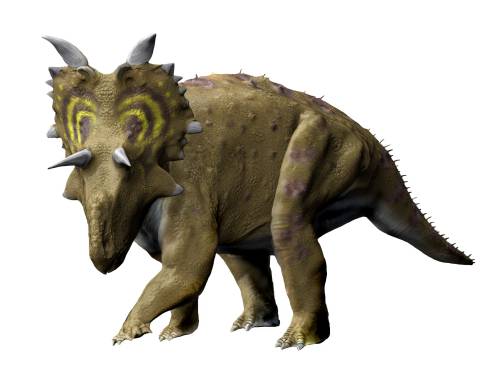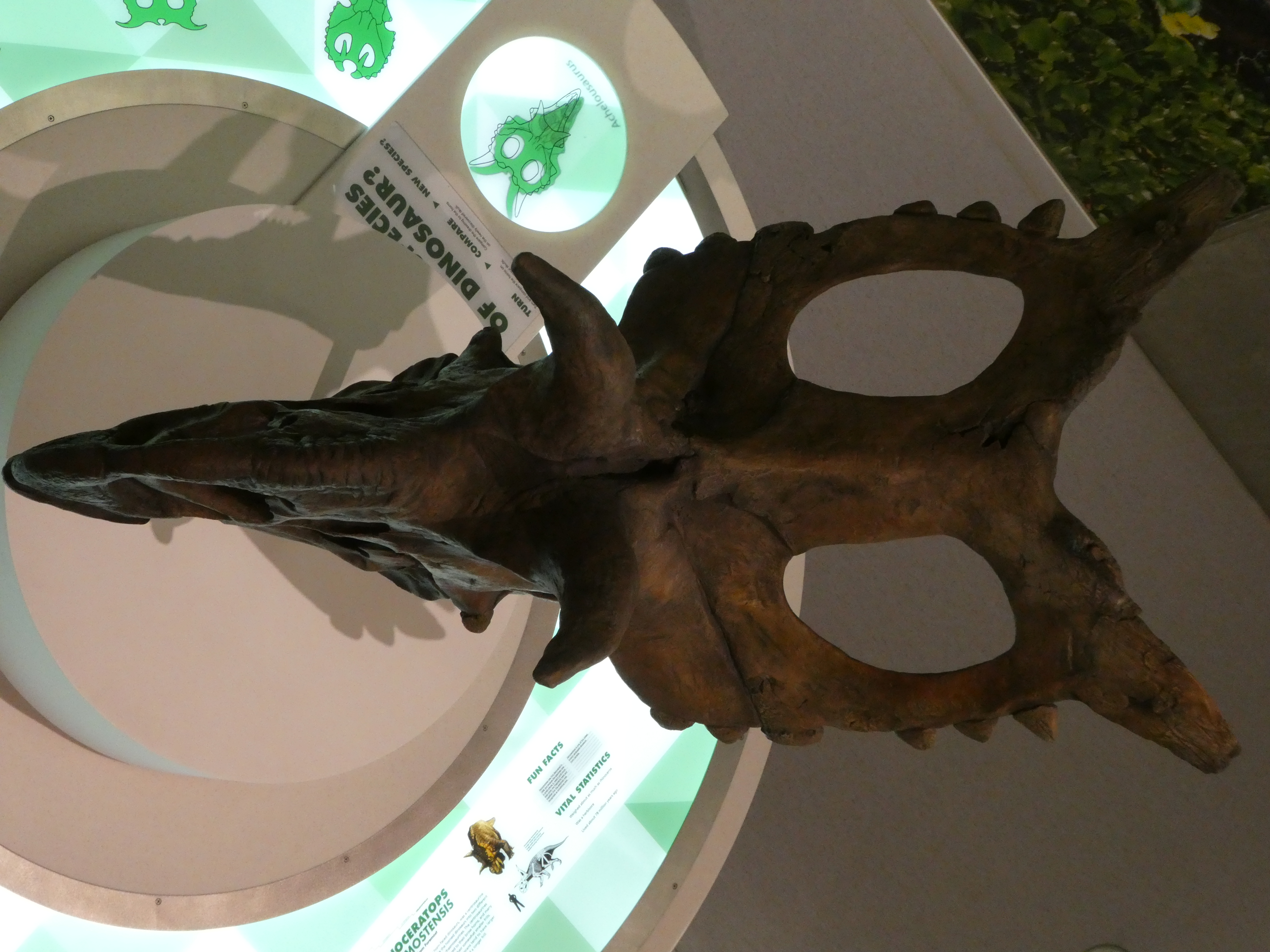Xenoceratops on:
[Wikipedia]
[Google]
[Amazon]
''Xenoceratops'' (meaning "alien horned face") is a
 ''Xenoceratops'' is based on CMN (Canadian Museum of Nature) 53282, a parietal. This is a skull bone that in ceratopsids makes up the medial (midline) and part of the lateral borders of the distinctive bony frill. Additional skull bones have also been assigned to the genus, including additional parietals, squamosals (bones which make up the rest of the frill's lateral borders), and a partial nasal. These bones appear to belong to at least three adult-sized individuals. Another fragmentary skull in the collections of the
''Xenoceratops'' is based on CMN (Canadian Museum of Nature) 53282, a parietal. This is a skull bone that in ceratopsids makes up the medial (midline) and part of the lateral borders of the distinctive bony frill. Additional skull bones have also been assigned to the genus, including additional parietals, squamosals (bones which make up the rest of the frill's lateral borders), and a partial nasal. These bones appear to belong to at least three adult-sized individuals. Another fragmentary skull in the collections of the

 The
The
genus
Genus ( plural genera ) is a taxonomic rank used in the biological classification of extant taxon, living and fossil organisms as well as Virus classification#ICTV classification, viruses. In the hierarchy of biological classification, genus com ...
of centrosaurine
Centrosaurinae (from the Greek, meaning "pointed lizards") is a subfamily of ceratopsid dinosaurs, a group of large quadrupedal ornithischians. Centrosaurine fossil remains are known primarily from the northern region of Laramidia (modern day Al ...
ceratopsid dinosaur
Dinosaurs are a diverse group of reptiles of the clade Dinosauria. They first appeared during the Triassic period, between 243 and 233.23 million years ago (mya), although the exact origin and timing of the evolution of dinosaurs is t ...
known from the Late Cretaceous
The Late Cretaceous (100.5–66 Ma) is the younger of two epochs into which the Cretaceous Period is divided in the geologic time scale. Rock strata from this epoch form the Upper Cretaceous Series. The Cretaceous is named after ''creta'', the ...
(middle Campanian
The Campanian is the fifth of six ages of the Late Cretaceous Epoch on the geologic timescale of the International Commission on Stratigraphy (ICS). In chronostratigraphy, it is the fifth of six stages in the Upper Cretaceous Series. Campanian s ...
stage), and is known to have lived in what is currently Alberta
Alberta ( ) is one of the thirteen provinces and territories of Canada. It is part of Western Canada and is one of the three prairie provinces. Alberta is bordered by British Columbia to the west, Saskatchewan to the east, the Northwest Ter ...
, Canada
Canada is a country in North America. Its ten provinces and three territories extend from the Atlantic Ocean to the Pacific Ocean and northward into the Arctic Ocean, covering over , making it the world's second-largest country by tot ...
. The genus has one known species, ''Xenoceratops foremostensis''. Its remains were discovered in the Foremost Formation
The Foremost Formation is a stratigraphic unit of Late Cretaceous (Campanian) age that underlies much of southern Alberta, Canada. It was named for outcrops in Chin Coulee near the town of ForemostGlass, D.J. (editor) 1997. Lexicon of Canadian S ...
.
Discovery
In 1958, Wann Langston, Jr. excavated skull fragments from theForemost Formation
The Foremost Formation is a stratigraphic unit of Late Cretaceous (Campanian) age that underlies much of southern Alberta, Canada. It was named for outcrops in Chin Coulee near the town of ForemostGlass, D.J. (editor) 1997. Lexicon of Canadian S ...
near Foremost, Alberta
Foremost is a village in Alberta, Canada. It is located southwest of Medicine Hat, along the Red Coat Trail, in the County of Forty Mile No. 8.
Foremost has a strong agriculture industry. Recreation facilities include an ice arena, swimming p ...
. The formation is very poorly understood in regards to dinosaur fauna; aside from teeth, only hadrosaur
Hadrosaurids (), or duck-billed dinosaurs, are members of the ornithischian family Hadrosauridae. This group is known as the duck-billed dinosaurs for the flat duck-bill appearance of the bones in their snouts. The ornithopod family, which incl ...
skeletons and the pachycephalosaurid
Pachycephalosauria (; from Greek παχυκεφαλόσαυρος for 'thick headed lizards') is a clade of ornithischian dinosaurs. Along with Ceratopsia, it makes up the clade Marginocephalia. With the exception of two species, most pachycephal ...
'' Colepiocephale'' have been reported.
Langston stored the fragments in cabinets at the Canadian Museum of Nature in Ottawa. Around 2003, David C. Evans and Michael J. Ryan became curious about the specimens, and more thorough investigation was conducted in 2009. They discovered it to be a new species and genus, and it was described in 2012 by Ryan, Evans, and Kieran M. Shepherd. At the time of discovery, ''Xenoceratops foremostensis'' was the oldest known taxon
In biology, a taxon (back-formation from ''taxonomy''; plural taxa) is a group of one or more populations of an organism or organisms seen by taxonomists to form a unit. Although neither is required, a taxon is usually known by a particular nam ...
of ceratopsid dinosaur in Canada. It is also the first ceratopsian
Ceratopsia or Ceratopia ( or ; Greek: "horned faces") is a group of herbivorous, beaked dinosaurs that thrived in what are now North America, Europe, and Asia, during the Cretaceous Period, although ancestral forms lived earlier, in the Jurassic ...
described from the Foremost Formation. ''Xenoceratops'' is named from the Greek ''xenos'', meaning foreign or alien, and ''ceratops'', meaning horned face. The combination is in reference to the lack of ceratopsian
Ceratopsia or Ceratopia ( or ; Greek: "horned faces") is a group of herbivorous, beaked dinosaurs that thrived in what are now North America, Europe, and Asia, during the Cretaceous Period, although ancestral forms lived earlier, in the Jurassic ...
species known from the Foremost Formation
The Foremost Formation is a stratigraphic unit of Late Cretaceous (Campanian) age that underlies much of southern Alberta, Canada. It was named for outcrops in Chin Coulee near the town of ForemostGlass, D.J. (editor) 1997. Lexicon of Canadian S ...
. The specific epithet ''foremostensis'' is named after the town of Foremost, Alberta
Foremost is a village in Alberta, Canada. It is located southwest of Medicine Hat, along the Red Coat Trail, in the County of Forty Mile No. 8.
Foremost has a strong agriculture industry. Recreation facilities include an ice arena, swimming p ...
.
Description
 ''Xenoceratops'' is based on CMN (Canadian Museum of Nature) 53282, a parietal. This is a skull bone that in ceratopsids makes up the medial (midline) and part of the lateral borders of the distinctive bony frill. Additional skull bones have also been assigned to the genus, including additional parietals, squamosals (bones which make up the rest of the frill's lateral borders), and a partial nasal. These bones appear to belong to at least three adult-sized individuals. Another fragmentary skull in the collections of the
''Xenoceratops'' is based on CMN (Canadian Museum of Nature) 53282, a parietal. This is a skull bone that in ceratopsids makes up the medial (midline) and part of the lateral borders of the distinctive bony frill. Additional skull bones have also been assigned to the genus, including additional parietals, squamosals (bones which make up the rest of the frill's lateral borders), and a partial nasal. These bones appear to belong to at least three adult-sized individuals. Another fragmentary skull in the collections of the Royal Tyrrell Museum of Palaeontology
The Royal Tyrrell Museum of Palaeontology (RTMP, and often referred to as the Royal Tyrrell Museum) is a palaeontology museum and research facility in Drumheller, Alberta, Canada. The museum was named in honour of Joseph Burr Tyrrell, and is sit ...
is thought to belong to this genus as well.
''Xenoceratops'' can be distinguished from other ceratopsids by details of the frill's bony ornamentation. The two bony projections closest to the midline of the frill are thick knobs, oriented toward the midline. Next to each knob is a single long flattened straight spike pointing laterally and to the rear. The anterior corners of the parietal have a large triangular knob. Unlike most other centrosaurines, the midline bar of the frill has no bumps or other ornamentation. ''Xenoceratops'' probably had a nasal and brow horn configuration comparable to that of other basal centrosaurines. The holotype and associated skull material do not include much of the face, but the Royal Tyrrell skull shows evidence of large brow horns, perhaps similar to those of ''Albertaceratops
''Albertaceratops'' (meaning "Alberta horned face") was a genus of centrosaurine horned dinosaur from the middle Campanian-age Upper Cretaceous Oldman Formation of Alberta, Canada.
Description
''Albertaceratops'' is unusual in combining long ...
'' and ''Diabloceratops
''Diabloceratops'' is an extinct genus of centrosaurine ceratopsian dinosaur that lived approximately 81.4-81 million years ago during the latter part of the Cretaceous Period in what is now Utah, in the United States. ''Diabloceratops'' was ...
''. Similarly, the form of the nasal bone fragment suggests a long, low structure like that of ''Medusaceratops
''Medusaceratops'' is an extinct genus of centrosaurine ceratopsian dinosaur known from the Late Cretaceous Judith River Formation (middle Campanian stage) of Montana, northern United States. It contains a single species, ''Medusaceratops lokii'' ...
''.
Classification

 The
The cladogram
A cladogram (from Greek ''clados'' "branch" and ''gramma'' "character") is a diagram used in cladistics to show relations among organisms. A cladogram is not, however, an evolutionary tree because it does not show how ancestors are related to d ...
below follows a phylogenetic analysis by Chiba ''et al.'' (2017):
See also
*Timeline of ceratopsian research
This timeline of ceratopsian research is a chronological listing of events in the history of paleontology focused on the ceratopsians, a group of herbivorous marginocephalian dinosaurs that evolved parrot-like beaks, bony frills, and, later, s ...
References
{{Taxonbar, from=Q18435 Fossil taxa described in 2012 Late Cretaceous dinosaurs of North America Centrosaurines Paleontology in Alberta Campanian genus first appearances Campanian genus extinctions Ornithischian genera